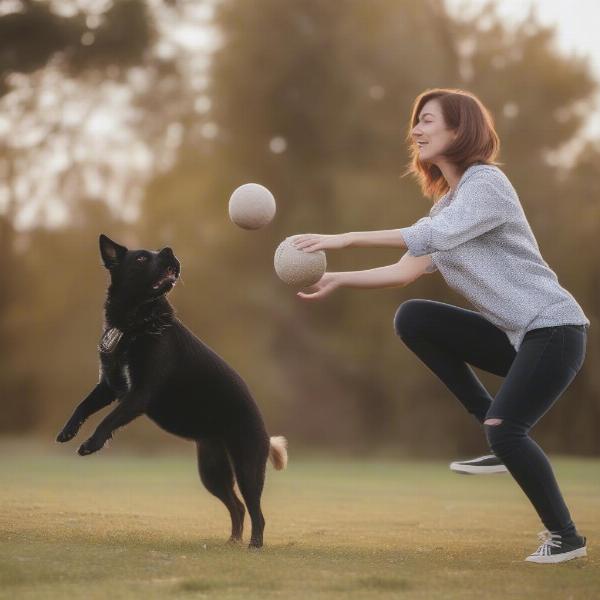Fetching is a natural instinct for many dogs, offering both physical and mental stimulation. This comprehensive guide explores the world of dogs fetching toys, covering everything from choosing the right toy to understanding the benefits and addressing potential challenges. We’ll delve into the joy of this simple activity, which strengthens the bond between you and your canine companion.
Why Do Dogs Love Fetching?
Dogs are descendants of wolves, who are natural hunters. The act of chasing and retrieving mimics this instinct, providing a healthy outlet for their energy. Fetching isn’t just about physical exercise; it’s a mentally engaging activity that helps prevent boredom and destructive behaviors. It also provides a fantastic opportunity for bonding and training, strengthening the relationship between dog and owner.
Choosing the Right Fetching Toy
Selecting the appropriate toy is crucial for a safe and enjoyable fetching experience. Consider your dog’s size, breed, and chewing habits. A small toy can be a choking hazard for a large dog, while a delicate toy won’t last long with a powerful chewer.
- Size and Shape: Opt for a toy that’s easy for your dog to grasp and carry in their mouth. Balls, frisbees, and rope toys are popular choices.
- Material: Durable materials like rubber, nylon, and canvas are ideal for enthusiastic chewers. Avoid toys that easily break apart or contain small parts that can be swallowed.
- Safety: Ensure the toy is non-toxic and free of harmful chemicals. Check for any sharp edges or loose parts that could pose a risk.
Teaching Your Dog to Fetch
Not all dogs instinctively know how to fetch. Some require a little encouragement and training. Here’s a step-by-step guide:
- Introduce the toy: Let your dog sniff and investigate the toy. Make it exciting by wiggling it or making playful sounds.
- Short throws: Start with short throws and encourage your dog to chase the toy.
- Reward the chase: When your dog reaches the toy, praise them enthusiastically.
- Encourage retrieval: If your dog picks up the toy, lure them back to you with a treat or another toy.
- “Drop it” command: Once they return, use the “drop it” command and reward them when they release the toy.
- Repeat and increase distance: Gradually increase the throwing distance as your dog progresses.
 Training Your Dog to Fetch
Training Your Dog to Fetch
Benefits of Fetching
Beyond the obvious physical benefits, fetching offers a range of advantages for your dog’s overall well-being:
- Physical exercise: Fetching helps maintain a healthy weight, builds muscle strength, and improves cardiovascular health.
- Mental stimulation: The act of chasing and retrieving provides mental engagement, reducing boredom and anxiety.
- Bonding: Fetching strengthens the bond between you and your dog through shared activity and positive reinforcement.
- Training: Fetching can be incorporated into training sessions to teach commands like “fetch,” “drop it,” and “come.”
Addressing Common Fetching Challenges
- Dog Doesn’t Bring the Toy Back: Try using a longer leash to gently guide your dog back to you.
- Dog Loses Interest Quickly: Introduce different toys to keep the game exciting. Vary the throwing distance and location.
- Dog Guards the Toy: Trade the retrieved toy for a treat or another toy to encourage sharing.
Conclusion
Dogs fetching toys is a rewarding activity that benefits both the dog and owner. By understanding your dog’s needs and choosing the right toys and training methods, you can foster a strong bond and ensure a happy, healthy life for your canine companion. Remember to keep the game fun and engaging for your furry friend, and enjoy the shared joy of this simple yet fulfilling activity.
FAQ
-
Q: What age can I start teaching my puppy to fetch? A: You can start introducing fetch as soon as your puppy is old enough to walk and run, usually around 8-12 weeks.
-
Q: What if my dog doesn’t like to fetch? A: Not all dogs enjoy fetching. Try other activities like tug-of-war or hide-and-seek to find what your dog enjoys.
-
Q: How long should I play fetch with my dog? A: Start with short sessions of 5-10 minutes and gradually increase the duration as your dog builds stamina.
-
Q: What if my dog gets too obsessed with fetching? A: Set clear boundaries and limit the number of fetching sessions per day. Provide other forms of enrichment, like puzzle toys or walks.
-
Q: Is it safe to play fetch with a frisbee? A: Frisbees can be safe if used correctly. Choose a soft frisbee designed for dogs and avoid throwing it too high or at sharp angles.
-
Q: My dog destroys every toy I give him. What can I do? A: Look for toys made from durable materials like heavy-duty rubber or nylon. Supervise your dog while they play and remove any damaged toys.
-
Q: Can I play fetch with my dog off-leash? A: Only play fetch off-leash in a safe, enclosed area where your dog can’t run into traffic or get lost.
ILM Dog is a leading international online resource for dog care and nurturing. We offer expert advice on dog breeds, health, training, nutrition, grooming, exercise, and much more. Whether you’re a new dog owner or a seasoned expert, ILM Dog provides reliable and practical information to help you provide the best possible care for your canine companion. For any inquiries, please contact us at [email protected] or +44 20-3965-8624. Visit ILM Dog for all your dog-related needs!